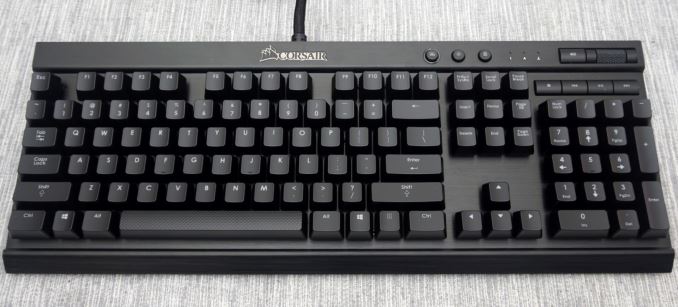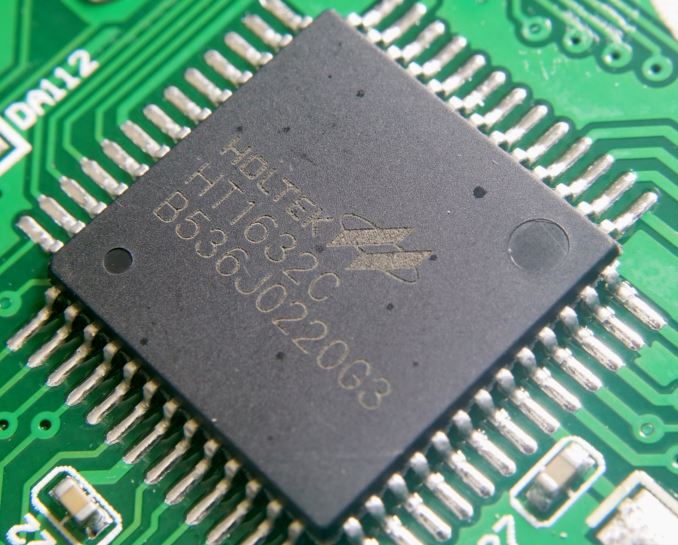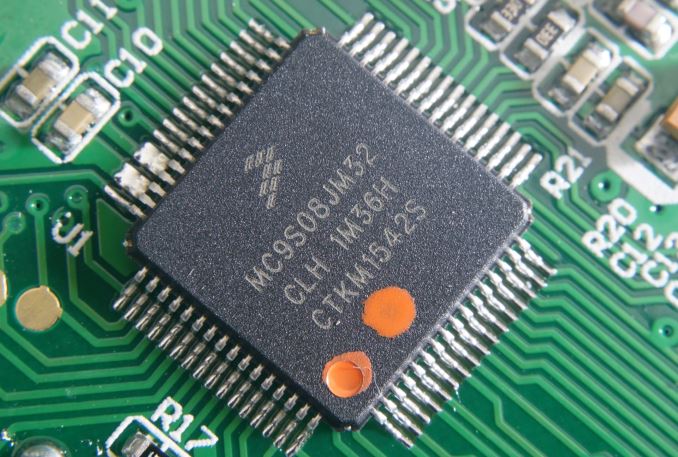The Corsair Lapdog Review: Gaming with a Mouse and Keyboard in the Living Room
by E. Fylladitakis on May 25, 2016 2:00 PM EST- Posted in
- Peripherals
- Corsair
- HTPC
- Mechanical Keyboards
The Corsair K70 Mechanical Keyboard
Even though we had a review of the K70 Mechanical Gaming Keyboard a couple of years ago, when it first came out in the market, we were not performing per-key quality testing at the time. The fresh sample that Corsair provided us for the means of this review gave us the chance to have a more thorough look at one of the most popular mechanical keyboards available worldwide.
Physically, the K70 remains unchanged since our first review two years ago, with the exception of the improved and clearer company logo. The keyboard still has ABS keycaps installed, with a textured Space Bar key and ten beveled red and textured gaming keycaps supplied separately. Our sample came with Cherry MX Red switches.
The heart of the K70 remains unchanged as well, as the keyboard is still making use of a Freescale MC9S08JM32 Microcontroller and a Holtek HT1632C LED driver. Therefore, with the exception of the clearer company logo, the K70 remains unchanged since our first look at it in 2014.
Per Key Quality Testing
In order to test the quality and consistency of a keyboard, we are using a texture analyser that is programmed to measure and display the actuation force of the standard keyboard keys. By measuring the actuation force of every key, the quality and consistency of the keyboard can be quantified. It can also reveal design issues, such as the larger keys being far softer to press than the main keys of the keyboard. The actuation force is measured in Centinewton (cN). Some companies use another figure, gram-force (gf). The conversion formula is 1 cN = 1.02 gf (i.e. they are about the same). A high quality keyboard should be as consistent as possible, with an average actuation force as near to the manufacturer's specs as possible and a disparity of less than ±10%. Greater differences are likely to be perceptible by users. It is worth noting that there is typically variance among keyboards, although most keyboard companies will try and maintain consistency - as with other reviews, we're testing our sample only.
The machine we use for our testing is accurate enough to provide readings with a resolution of 0.1 cN. For wider keys (e.g. Enter, Space Bar, etc.), the measurement is taking place at the center of the key, right above the switch. Note that large keys generally have a lower actuation force even if the actuation point is at the dead center of the key. This is natural, as the size and weight of the keycap reduces the required actuation force. For this reason, we do display the force required to actuate every key but we only use the results of the typical sized keys for our consistency calculations. Still, very low figures on medium sized keys, such as the Shift and Enter keys reveal design issues and can easily be perceptible by the user.
The Corsair Gaming K70 Mechanical Gaming Keyboard proved to be exceptionally consistent, even for a keyboard using Cherry MX switches. The actuation force rating of the Cherry MX Red switches that the K70 is making use of is 45 cN. Our equipment measured an average of 45.1 cN, with a disparity of only ± 1.94%. We usually expect to see a disparity of at least ± 3% and we prefer it to be lower than ± 8%. Readings below ± 3% are exceptional and very rare. Normally it will be a case of 'your mileage may vary', and for as rare as they may be these readings are similar to those of the Corsair STRAFE Mechanical Keyboard as well, reducing the possibility that the outstanding consistency of the switches we are getting from Corsair’s products is due to luck.















38 Comments
View All Comments
ianmills - Wednesday, May 25, 2016 - link
lol this looks like an all in one computer from the 80'sWildW - Wednesday, May 25, 2016 - link
I'm having flashbacks to the Phantom lapboard.lllllllllllll - Wednesday, May 25, 2016 - link
- No wireless option.- Terrible usability.
To get off a couch you need to use one hand for a mouse and other for the lapdog.
smartthanyou - Wednesday, May 25, 2016 - link
Or just get a wireless keyboard and Logitech Wireless Trackball M570 and be done with it.Ascaris - Wednesday, May 25, 2016 - link
I always do my gaming with a mouse and keyboard in the living room.That's where my computer desk is!
Fallen Kell - Wednesday, May 25, 2016 - link
Yeah, at $120, you are so much better off buying a custom sized "cutting board" (something like 28"x7.5") (~approx $20-30 shipped), some DualLock (a velcro alternative that holds extremely well) ($5), a USB hub ($15), and an extra long USB cable ($10) and call it a day. You gain the ability to size the board to any keyboard you own, can also adjust the size of the mouse area to be the same as your normal mousepad. Add a couple screw-down cable/wire holders for another $1, and you have just made a much better device and cost you 1/2 the price.xthetenth - Saturday, June 4, 2016 - link
I think the main difference is the word made. Some people don't want to make something, and for them the time and effort is worth paying the money to avoid.HollyDOL - Thursday, May 26, 2016 - link
It seems to be quite suprising it requires another power supply... Given my old MS Natural keyboard Pro (the white/light gray one) can feed itself and via two USB ports a mouse and a USB flash stick. And that's running with USB1.1 power limitations.Ian Cutress - Thursday, May 26, 2016 - link
It only needs the power supply if you want to run heavy duty USB devices from the keyboard, like charging a phone.HollyDOL - Thursday, May 26, 2016 - link
Ic, that's fine then :-)